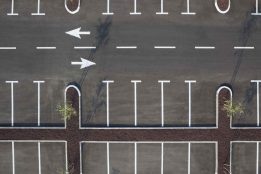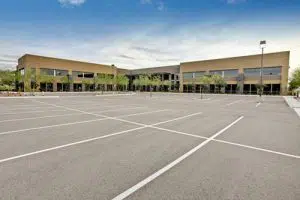
Paint vs extruded thermoplastic
 There are many places where you will have noticed that line marking has been undertaken. If you drive a car or ride a motorbike, you will have seen line marking on all of our roads. If you go into a carpark area, you will see road markings for directing traffic and for setting out where the parking spaces are located. They are used throughout a multi-storey commercial carpark in large shopping centres. They will be used to clearly mark which are handicapped parking spaces and where no parking is allowed. They can be used to differentiate different types of zones, or areas in a factory carpark. They are used for directing traffic at busy airports. They identify no stopping areas and cross-hatching intersections in cities where traffic must not overflow during peak periods.
There are many places where you will have noticed that line marking has been undertaken. If you drive a car or ride a motorbike, you will have seen line marking on all of our roads. If you go into a carpark area, you will see road markings for directing traffic and for setting out where the parking spaces are located. They are used throughout a multi-storey commercial carpark in large shopping centres. They will be used to clearly mark which are handicapped parking spaces and where no parking is allowed. They can be used to differentiate different types of zones, or areas in a factory carpark. They are used for directing traffic at busy airports. They identify no stopping areas and cross-hatching intersections in cities where traffic must not overflow during peak periods.
The use of road marking has become a very valuable and practical element of road safety. They are able to indicate to drivers a change in traffic conditions that lie ahead, such as a roundabout or a pedestrian crossing. By having clear lines on the sides of country highways, it is clearer to drivers about the width and shape of the road which is able to help prevent accidents, particularly at night. There is the line marking in the centre of the road to indicate when it is safe to overtake. Knowing about road markings is a normal part of driver safety knowledge testing. It is simply a part of using the road.
Painting line markings on roads
For many years roads were being marked using paint products. The technology of paint was developing and the application of the paint to the surface of the road was an easy, reasonably quick, and relatively inexpensive process. The types of paint products to be used could contain additives to improve their visibility and longevity, but the reality for using paint on roads is that quite quickly it will be negatively impacted by traffic. If you have heavy trucks driving over painted lines, then only after a few months they will be damaged, and they may have lost their brightness. This means that to keep lines looking fresh they need to be painted on a regular basis. In effect, the cheapness of the process is not such a saving as the number of times the process needs to be undertaken will add to the ongoing expense.
Another consideration was that when lines become less clear over time, through weather and traffic impacts, their light reflectivity at night diminishes. This makes it difficult for drivers to be able to see line markings clearly, which is highly problematic. This could lead to drivers not seeing the markings for pedestrian crossings, or not being able to see where a lane has been marked as changing direction. These are only two scenarios and both examples have the potential to end in tragic accidents.
For this reason, those working in this field were looking for other effective ways of undertaking line marking that would offer a suitable alternative to paint. This involved identifying an economical method that would increase the longevity of the markings and also ensure that they were highly visible during night time driving.
Extruded thermoplastics
 As a result, there have been substantial developments in the materials being used and the way that line marking is being undertaken. The most effective method that is currently being used is with extruded thermoplastics. At normal temperatures, the thermoplastic compound is a solid. It will usually contain a mixture of pigments for colour, a binder for strengthening the compound, and filler materials to help create the bulk. When heat is applied it becomes a liquid that makes it possible to be applied for road marking. In addition, the use of heat can also be used to melt a cementing compound, which when cooled to normal temperatures binds the thermoplastic very effectively to the road surface. Owing to the need to melt the blocks of thermoplastic, and that it must be applied while still warm to the road surface, there is a requirement for more sophisticated line marking equipment to be used.
As a result, there have been substantial developments in the materials being used and the way that line marking is being undertaken. The most effective method that is currently being used is with extruded thermoplastics. At normal temperatures, the thermoplastic compound is a solid. It will usually contain a mixture of pigments for colour, a binder for strengthening the compound, and filler materials to help create the bulk. When heat is applied it becomes a liquid that makes it possible to be applied for road marking. In addition, the use of heat can also be used to melt a cementing compound, which when cooled to normal temperatures binds the thermoplastic very effectively to the road surface. Owing to the need to melt the blocks of thermoplastic, and that it must be applied while still warm to the road surface, there is a requirement for more sophisticated line marking equipment to be used.
One of the simple but highly effective innovations for improving the functionality of this material has been the introduction of tiny glass beads into the thermoplastic compound mix. This has substantially increased the reflectivity of the product and the road markings. The glass beads are spread out through the whole of the thermoplastic compound so that even when the lines have been worn down as a result of being subjected to high traffic flow, they will still continue to be highly visible, particularly at night. Thermoplastics may not be as cheap as paint, but the benefits they bring to road safety, and the longevity of the material, makes them a very suitable and highly effective alternative.
Painting line markings in carparks
There may still be situations where the use of paint is a suitable consideration. Carparks are often areas where there will be a combination of pedestrian and vehicular traffic. Whether it is a commercial carpark or a factory carpark, there need to be clear line markings to prevent confusion and to ensure that areas are clearly delineated. In areas which are not subjected to heavy traffic or where they are not impacted by weather conditions, there may be the opportunity to use paint products. There may not need to have high levels of reflectivity at night as well, and so paint becomes a suitable and cheaper option.
Speak with line marking professionals
If you are considering undertaking line marking work, it is important to speak to an organisation that has experience in this area. There is a range of options available that could be suitable for a project. It is important to understand the full range of requirements for the project and then be able to make an informed decision about which is the best material and process to be applied to meet all of the requirements.
Mainliner is able to assist with a large variety of solutions with professional and practical expertise in working across a range of environments and will be able to provide clear and valuable advice for your project. Contact our line marking professionals at (03) 9308 2732 today.

